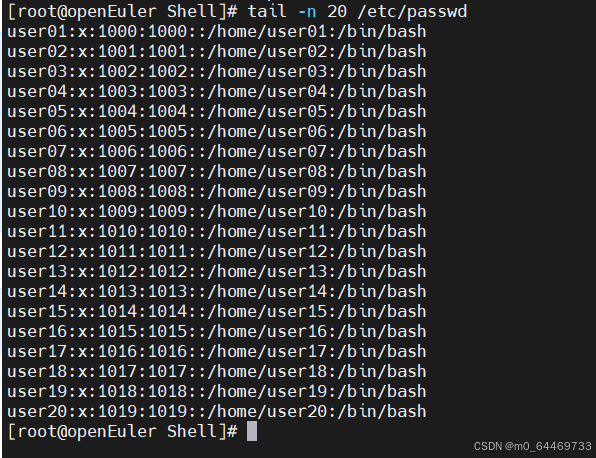1、shell 脚本写出检测 /tmp/size.log 文件如果存在显示它的内容,不存在则创建一个文件将创建时间写入。
[root@openEuler Shell]# vim 2.sh
#!/bin/bash
#########################
#File name:2.sh
#Version:v1.0
#Email:admin@test.com
#Created time:2025-01-11 14:13:13
#Description:
#########################
read -p "请输入文件名: " file
if [ -e $file ]
then
cat $file
else
touch $file
echo $(date) >> $file
fi
[root@openEuler Shell]# sh 2.sh
2、写一个 shell 脚本,实现批量添加 20个用户,用户名为user01-20,密码为user 后面跟5个随机字符。
[root@openEuler Shell]# vim 3.sh
#!/bin/bash
#########################
#File name:3.sh
#Version:v1.0
#Email:admin@test.com
#Created time:2025-01-11 16:55:24
#Description:
#########################
for i in `seq -w 01 20`
do
random=$(cat /dev/urandom | tr -dc 'a-zA-Z0-9' | fold -w 5 | head -n 1)
username="user${i}"
password="user${random}"
#echo $username
#echo $password
useradd $username
echo "$password" | passwd --stdin $username
done
[root@openEuler Shell]# sh 3.sh

3、编写个shell脚本将/usr/local 日录下大于10M的文件转移到/tmp目录下
[root@openEuler Shell]# vim 4.sh +
#!/bin/bash
#########################
#File name:4.sh
#Version:v1.0
#Email:admin@test.com
#Created time:2025-01-11 17:40:34
#Description:
#########################
#!/bin/bash
read -p "请输路径:" filepath
files=$(find $filepath -type f -size +10M)
for file in $files
do
filename=$(basename $file)
mv $file /tmp/$filename
done
